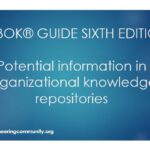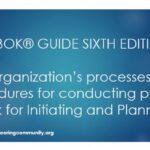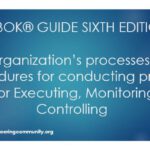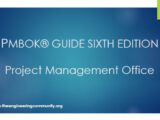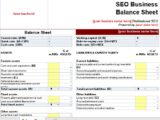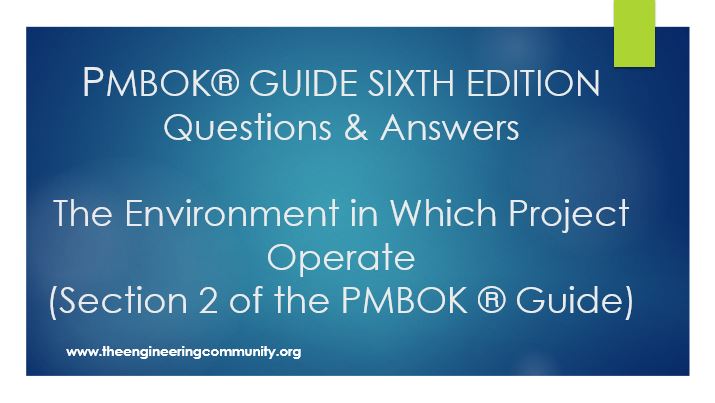
PMBOK® GUIDE SIXTH EDITION Questions & Answers The Environment in Which Project Operate
7 March 2021Table of Contents
PMBOK® GUIDE SIXTH EDITION
Questions & Answers
The Environment in Which Project Operate
Questions:
1. Which of the following best describe management elements?
A. Management elements are the components that comprise the key functions or principles of general management in the organization.
B. Management elements are the project management principles that guide how projects are executed in the organization.
C. Management elements are established by PMOs to guide project implementation.
D. Management elements are influenced by the governance framework, established for effective implementation of projects.
2.Governance is the framework within which authority is exercised in organizations. This framework includes all of the following components EXCEPT:
A. Rules.
B. Policies.
C. Techniques.
D. Relationships .
3. The interaction of the various system components creates the organizational culture and capabilities that are important for projects. Which role is typically responsible for establishing the system?
A. Organization’s management.
B. Project sponsor.
C. Project manager.
D. Project team.
4. Projects operate within the constraints imposed by the organization through their structure and governance framework. The system factors include all of the following EXCEPT :
A. Management elements.
B. Governance framework.
C. Organizational structure types.
D. Project management processes .
5.The organization’s processes and procedures for conducting project work during Executing, Monitoring, and Controlling include all of the following EXCEPT:
A. Change control procedure.
B. Issue and defect management procedures.
C. Resource availability control and assignment management.
D. Project closing guidelines.
6.The organization’s processes and procedures for conducting pro ject work during project initiation and planning include all of the following EXCEPT :
A. Preapproved supplier list.
B. Traceability matrices.
C. Tailoring guidelines for project management processes and procedures.
D. Product and project life cycles, and methods and procedures.
7. Organizational process assets (OPAs) influence the management of projects. Which one of the following best describes the important categories of OPAs?
A. Organizational knowledge bases and processes
B. Processes, policies, procedures, tools, and techniques.
C. Organizational knowledge bases, processes, policies, and procedures.
D. Organizational knowledge bases, tools, and techniques.
8. All of the following are external environmental factors EXCEPT :
A. Legal restrictions.
B. Organizational values and principles.
C. Competitive movements.
D. Economic conditions .
9.All of the following are potential information in organizational knowledge repositories EXCEPT :
A. Metrics used to collect and make available measurement data on processes and products.
B. Configuration management.
C. Tacit knowledge of previous projects such as project performance data and lessons learned.
D. Issue and defect management data.
10.A primary function of a project management office (PMO) is to support project managers in a variety of ways, which may include all of the following EXCEPT:
A. Intervening in project execution directly and without involving the project manager.
B. Managing shared resources across all projects administered by the PMO.
C. Identifying and developing project management methodology, best practices, and standards.
D. Coaching, mentoring, training, and oversight .
11.The types of project management office (PMO) structures in organizations include all of the following EXCEPT :
A. Supportive PMOs that provide a consultative role to projects by supplying templates, best practices, training, access to information, and lessons learned from other projects.
B. Controlling PMOs that provide support and require compliance through various means.
C. Harmonizing PMOs that strive to reduce conflict and improve harmony among project team members.
D. Directive PMOs that take control of the projects by directly managing the projects.
12. Enterprise environmental factors refer to both internal and external environmental factors that surround or influence a project’s success. All of the following are true about these factors EXCEPT :
A. Enterprise environmental factors include organizational culture, structure, and processes.
B. Enterprise environmental factors include government or industry standards, such as regulatory agency regulations, codes of conduct, product standards, quality standards, and workmanship standards.
C. Enterprise environmental factors include information technology software (e.g., an automated tool, such as a scheduling software tool, a configuration management system, an information collection and distribution system, or web interfaces to other online automated systems).
D. Enterprise environmental factors exclude personnel administration functions (e.g., staffing and retention guidelines, employee performance reviews and training records, and time tracking) because these are considered to be functions of the human resources department .
Answers:
1. Answer: A.
PMBOK® Guide, pages 44 – 45, Section 2. 4. 3
Management elements are the components that comprise the key functions or principles of general management in the organization. The general management elements are allocated within the organization according to its governance framework and the organizational structure type selected.
2. Answer: C .
PMBOK® Guide, page 43, Section 2. 4. 2. 1
Governance Framework in Project Management
3. Answer: A .
PMBOK®Guide, page 42, Section 2. 4. 1
Systems are typically the responsibility of an organization’s management. The organization’s management examines the optimizational trade-offs between the components and the system in order to take the appropriate action to achieve the best outcomes for the organization. The results of this examination will impact the project under consideration.
The following EEFs are external to the organization:
- Marketplace conditions. Examples include competitors, market share brand recognition, and trademarks.
- Social and cultural influences and issues. Examples include political climate, codes of conduct ethics, and perceptions.
- Legal restrictions. Examples include country or local laws and regulations related to security, data protection, business conduct, employment, and procurement.
- Commercial databases. Examples include benchmarking results, standardized cost estimating data, industry risk study information, and risk databases.
- Academic research. Examples include industry studies, publications, and benchmarking results.
- Government or industry standards. Examples include regulatory agency regulations and standards related to products, production, environment, quality, and workmanship.
- Financial considerations. Examples include currency exchange rates, interest rates, inflation rates, tariffs, and geographic location.
- Physical environmental elements. Examples include working conditions, weather, and constraints.
- An organization’s value and principle, while not explicitly stated, are related to organizational culture and thus are internal to an organization
4. Answer: D .
PMBOK®Guide, page 42, Section 2. 4. 1
Projects operate within the constraints imposed by the organization through their structure and governance framework. To operate effectively and efficiently, the project manager needs to understand where responsibility, accountability, and authority reside within the organization. This understanding will help the project manager effectively use his or her power, influence, competence, leadership, and political capabilities to successfully complete the project.
The interaction of multiple factors within an individual organization creates a unique system that impacts the project operating in that system. The resulting organizational system determines the power, influence, interests, competence, and political capabilities of the people who are able to act within the system. The system factors include, but are not limited to:
- Management elements,
- Governance frameworks, and
- Organizational structure types.
Project managers should consider tailoring the project management processes based on these
system factors.
5. Answer: C .
PMBOK®Guide, pages 40 – 41, Section 2. 3. 1
6. Answer: B .
PMBOK®Guide, page 40, Section 2. 3. 1
The organization’s processes and procedures for conducting project work for Initiating and Planning
7. Answer: C .
PMBOK®Guide, page 39, Section 2. 3
Organizational process assets (OPAs) are the plans, processes, policies, procedures, and knowledge bases specific to and used by the performing organization. They may be grouped into two categories:
- Processes, policies, and procedures; and
- Organizational knowledge bases.
8. Answer: B .
PMBOK®Guide, page 39, Section 2. 2. 2
Enterprise Environmental Factors
9. Answer: C .
PMBOK®Guide, page 41, Section 2. 3. 2
Potential information in organizational knowledge repositories
10. Answer: A .
PMBOK® Guide, page 49, Section 2. 4. 4. 3
11. Answer: C.
PMBOK® Guide, pages 48 – 49, Section 2. 4. 4. 3
There are several types of PMO structures in organizations, each varying in the degree of control and influence they have on projects within the organization, such as the following:
- Supportive. Supportive PMOs provide a consultative role to projects by supplying templates, best practices, training, access to information, and lessons learned from other projects. This type of PMO serves as a project repository. The degree of control provided by the PMO is low.
- Controlling. Controlling PMOs provide support and require compliance through various means.
Compliance may involve adopting project management frameworks or methodologies; using specific templates, forms, and tools; or conformance to governance. The degree of control provided by the PMO is moderate. - Directive. Directive PMOs take control of the projects by directly managing the projects. The degree of control provided by the PMO is high.
12. Answer: D .
PMBOK®Guide, page 38, Section 2. 2. 1



